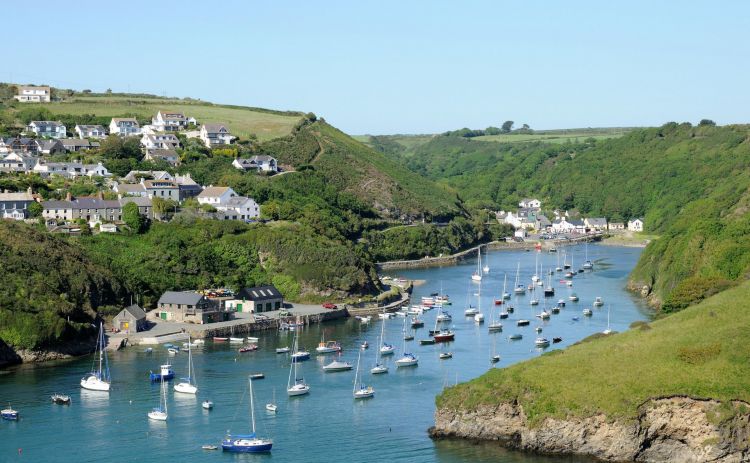Broadstairs, Kent
Broadstairs must be in my blood. My mum’s family has been going there at least since Edward VII was on the throne. We have an old album of photographs of her parents horsing around in what is presumably Viking Bay. In one picture, my grandfather is posing in a woollen bathing suit with a half-crown stuck in his eye-socket as though it’s a monocle. Considering that he wasn’t known for his levity and that at the time it was taken, in the mid-1930s, the economy had gone south and the world stood on the brink of a terrible war, it says something about the restorative powers of Broadstairs.
Viking Bay, the most popular beach, is less than 10 minutes on foot from the train station. It’s a microcosm of the pleasures of the English seaside: a sweep of golden sand, rented deckchairs, chips on the beach — watch out for the predatory seagulls! — and excellent swimming at high tide. At low-tide, a square paddling pool emerges from the waves. It’s so choked with seaweed that I’m not sure it’s a great place to paddle, but it’s an excellent place to look for crabs. At the southern edge of the curved beach there are fairground attractions: swing-boats, bouncy castles, trampolines. The very adventurous can take surfing or stand-up paddleboard lessons. Or you could just sit under an umbrella and practise the card tricks you bought at Wormwolds Emporium of Magic on the way from the station.

Broadstairs beach. Photograph: Peter Lourenco/Getty Images
When you’ve had too much sun, or if you’re rained off the beach, take refuge in Bessie’s Tea Parlour, where the vintage china and cream teas evoke an atmosphere in which my great grandparents would have felt at home. Fortunately, the food in general has changed beyond recognition. In addition to excellent ice-cream places and great fish and chips, there are a bunch of upmarket restaurants, of which Wyatt and Jones (lunch from £6, dinner mains from £16.50) strikes me as particularly nice. Another possibility is an improving visit to the Dickens House Museum, overlooking the bay. One of its former occupants was the inspiration for the formidable Betsey Trotwood in David Copperfield. The tiny museum celebrates the novelist’s links with the area. “What larks!” as the great man might have put it.
Stay: The Yarrow is a hotel, restaurant and spa owned by a further education college and run by its students with 23 double/twin rooms. Doubles from £80 B&B
Marcel Theroux, author The Secret Books, published in September
Millport, Ayrshire

Millport, on the island of Cumbrae. Photograph: Alamy
During the fleeting Scottish summer, on those rare shoulder-baring days when the temperature nudges up to a level known as “taps aff”, quite a few Glaswegians take themselves off to Millport.
This magical little town is on the tiny island of Cumbrae in the Firth of Clyde, 35 miles west of Glasgow. As a treat, it’s fun to travel on board the Waverley paddle steamer with its smart funnels of black, white and red. The more usual thing is to take the little ferry from Largs; the crossing lasts just 10 minutes but imparts a delightful feeling of leaving the world behind; one’s cares dissolve in the milky wake. Do linger long enough in Largs to visit Nardini’s, Scotland’s most celebrated ice-cream parlour, and enjoy some elaborate confection of cherries and wafers and scoops in the grand art deco interior.

The Ritz Cafe, ‘a Formica wonderland which appears unchanged since the 1960s.’ Photograph: Douglas Carr/Alamy
Lots of people take bicycles on the ferry, or hire them in Millport. You can cycle around the whole island in a leisurely hour and a half. The best beaches are on the western side, with gorgeous views over to Arran and Bute. It’s much quieter round there, but I’m not sure Cumbrae is really the place for solitude. Millport itself is busy and glorious. Lacking the Miss Havisham sadness of those seaside resorts long jilted by holidaying hordes, it retains the optimistic cheer of a new bride. This town is loved, and knows it.
The main drag faces on to the beach. There’s not much to this strip of sand, but I’ve sat there for hours while the kids mucked about in crab pools or clambered over “Crocodile Rock”, the iconic painted boulder which, for more than a century, has been emblematic of Millport’s gaudy charm. Eventually, there comes a point when the seals basking just off the beach seem too accurate a mirror to personal indolence, and one feels compelled to rise and move. Not too far, though. Heed the siren call of the Ritz Cafe, a Formica wonderland which appears unchanged since the 1960s. This is the place for chips and milkshakes, proper ballast for the boat home.
Stay: Millport Beach Apartments, two airy two-bedroom pads above the Ritz Cafe, overlook the beach. From £95 a night
Peter Ross, author of Daunderlust – Dispatches from Unreported Scotland
Bangor, County Down

The massed masts of Bangor Marina. Photograph: Alamy
Bangor was never a holiday destination for me as a child, it was scarcely even a day trip. Bangor was a “run” after dinner on a summer’s evening, the dishes left in the sink, and the six of us – my parents, three brothers and me –piled into the car with the promise of slot machines, crazy golf and a clamber over rocks at the other end.
In the years since, Bangor has done a good job of disguising the fact that it’s a seaside town at all. There are acres of supermarkets and retail parks to negotiate on the approach. Take the wrong slip road off the A2 and you can be out the other side without ever catching a whiff of water.

Street entertainers at the McKee Clock, the start of the Bangor seafront. Photograph: Alamy
The train from Belfast is far more pleasant, the track running for much of the journey tight to the southern shore of Belfast Lough. Almost the first thing you will see, coming out of the station, is the Ava Winebar, a Bangor legend and my first (and frequently last) port of call when I started going with friends in my teens.
Half a mile further on, down Main Street, the McKee Clock has for the past century marked the start of the seafront, though where once there was beach (of sorts) beyond there are now the massed masts of Bangor Marina. It boasts five gold anchors, if that floats your own boat. If it’s actual sand you’re after, follow the Seacliff Road the short distance round to Ballyholme. Here, where the road narrows to a single lane between the seawall and terraces of fine stone houses, is the Bangor of those childhood summer evenings, no worse – in terms of visual drama, better – for the clouds gathering on the hills across the Lough.
Never mind a run, or even a day trip. I could spend the week here rightly.
Stay: The garden of Splash Cottage backs on to the sea, is set over three levels and sleeps six. From £700 a week
Glenn Patterson, author of Gull, a fictionalised take of the DeLorean
Budleigh Salterton, Devon

Simple pleasures – enjoying the view over the beach at Budleigh Salterton. Photograph: Alamy
The estuary at Budleigh Salterton, where the river Otter winds through salt marshes to the sea, is the most peaceful place I know. It’s not peaceful in the sense of silent: there are gulls, geese and curlews, the high call of sandpipers and the roar of waves breaking on the other side of the shingle ridge. But the water here has a mercury stillness, so that surfacing fish make ripples and the cliff above is mirrored. What a cliff it is: glowing terracotta sandstone, the orange deepened by the green turf above, and standing tall on its ridge – rather oddly and exotically – a row of Scots pines.
If you follow the path upriver you may see a kingfisher flash between the reeds. At Otterton, the watermill still grinds the flour for excellent scones served in the courtyard, and upriver again is Coleridge’s home village, Ottery St Mary. But if you follow the river to the sea you’ll find the spot from which a skilfully aimed pebble can be thrown at sunset across the eddying water to land on a red ridge in the cliff-face opposite.

Mouth of the River Otter at Budleigh Salterton. Photograph: Kevin Rushby for the Guardian
This is the far point of Budleigh’s promenade and it’s time to stroll into town. The early Victorian houses are painted in nautical black or white rather than holiday pastels; the brass door knockers are always shiny. Past The Crusty Rolle and the The Cosy Teapot are the drapers and dress shops where yellow film keeps the sun off the window displays. The average age of residents must be somewhere in the later 70s, it’s true, but older people have excellent taste in seasides and I’m glad to join them when I can. There are younger people arriving in any case; Earl’s Coffee (opened in 2016) stylishly fulfils any need for wifi and a good americano.
The old things have endured through the 25 years since I first knew this town. Whenever I’ve bought an ice-cream from The Creamery (30 flavours to choose from) and taken it out to one of the prime benches along the front, I’ve noticed that the other seats are occupied by people watching the view together with a rare degree of pure contentment.
Stay: Heath Close House is a five-star B&B a short walk from the South West Coastal path, with five rooms from £52.50pp a night
Alexandra Harris, author of Weatherland: Writers and Artists under English Skies
Craster, Northumberland

Embleton Bay with Dunstanburgh Castle in the distance. Photograph: Alamy
With its broken towers and notched curtain wall, Dunstanburgh looks like a child’s sand castle battered by successive tides. Built on a defensive promontory, an outcrop of the Great Whin Sill, it was sketched and painted a number of times by Turner. It’s a one-mile walk here from Craster harbour after coffee and homemade scones at The Shoreline Café. The path crosses sheep-cropped turf that in autumn is studded with crimson, orange and emerald buttons – waxcap fungi gleaming like jewels. By winter the North Sea pounds against the rocks and curlew and golden plover cry plaintively. In spring the flowering banks of gorse smell like pineapple, and summer is when the county flower of Northumberland, the bloody cranesbill, blooms. I am drawn back here at all times of the year.

The Jolly Fisherman pub
Craster is a small fishing village on the Northumbrian coast. Within its two protective piers, turnstones pick through the bladderwrack or bathe in tiny pools. A robin nips in and out of lobster pots that are piled high between the white painted cottages and the boats that rest at jaunty angles on the harbour slope. There’s a simple stone shed housing the lifeboat, crewed by local volunteers. The scent of wood smoke from Robson’s Smokehouse, where herrings are cured over smouldering oak sawdust, waft around the village.
Past the red pantiled houses of Haven Hill it’s a short step to the Jolly Fisherman. On still days I sit outside, or when it’s blowing, take shelter with a window seat and a view of Dunstanburgh Castle. The pub is known for its crab sandwiches and its crab soup served with slabs of sourdough loaf from artisan bakery Bread and Roses. Lunch can be spent watching cormorants dry their wings on the rocky skerries below and eider ducks bob as they ride the swell. Later, I like to wander in the plant lovers’ paradise of Howick Hall Gardens or take home a parcel of oak-smoked kippers for tea.
Stay: The Joiners Arms in Newton-by-the-Sea is a gastro-inn with five bedrooms that have four-poster beds and roll-top baths. Doubles from £140 B&B
Susie White, Guardian country diarist
Solva, Pembrokeshire

Inlet idyll … Solva harbour and village in Pembrokeshire. Photograph: Alamy
In a land steeped in mystery, magic and mythology, far beyond the prying eyes of modern times, at the edge of the Pembrokeshire, lies the small harbour village of Solvach, or Solva in English, the setting for the remake of the 2015 film version of Under Milk Wood.
Some say it was an old pirates’ harbour, as from the sea you could easily miss it. Some say it still is. The modern day characters of Solva are no less intriguing than their predecessors – and there’s still a true sense of community here.
Solva was built along a river valley bottom, a collection of old fishermen’s cottages. The countryside is farmers’ territory – think big hedges and slow roads. Visitors will find kids on the quay crabbing and jumping off the slip into the sea, just as they’ve done for generations.

The village of Solva. Photograph: Alamy
Totem-like cliffs frame the harbour, and the view out to the bay. My top tip is to walk the coast path south towards Newgale, passing hidden bays, beaches and coves. And perhaps drop a few mackerel feathers and cook up some fish on the beach under the super-clear Pembrokeshire skies.
One wistful walk is from Solva Woollen Mill (the oldest of its kind in the county – I still use their woollen blankets that were made in the 1970s!) to the harbour a mile away. The river meanders peacefully past sheep and the odd alpaca, a hidden gudel (a passageway to the river where folk would have done their washing), a number of pubs, such as The Ship and Harbour Inn; art galleries such as Raul Speaks; and a cafe, Thirty Five. From the harbour take a 10-minute walk over the headland of the Gribin to Gwaden cove.
Stay: Crug-Glas is a country house, restaurant and farm with five bedrooms and a couple of cottage suites. Doubles from £150 B&B
Tim Rees is based in Solva and is founder of the Unearthed Festival
Scarborough, North Yorkshire

Sundae best … the Harbour Bar.
Photograph: Gary Calton for the Observer
Scarborough can rightfully claim to be Britain’s first seaside resort. It was only after a local quack, Dr Wittie, began to prescribe the town’s spa and sea water as a cure for gout in the late 17th century that the affluent unwell started to wash up on our coasts.
The town combines the historic, scenic, majestic and elegant with the fun, gaudy and outright kiss-me-quick kitsch. The skyline of its South Bay is dominated by the Grand Hotel, once the largest hotel in Europe and built in the 1860s on the site of the guesthouse where Anne Brontë expired (her grave is in St Mary’s churchyard). Fashioned in yellow brick, this crenellated building with four domed towers looks not unlike a majestic sandcastle and is neatly complemented by the scenic ruins of an actual ancient castle on the peak of the South Bay opposite.

Donkey rides on the beach. Photograph: Alamy
At beach level, best reached by the Cliff Lift, the first and oldest funicular railway in operation in the country, its tartrazine yellow sands continue, compellingly, to be graced by donkeys.
Advertisement
Tucked between the flashing lights of the south sands amusement arcades and various souvenir shops there is the incomparable Alonzi’s Harbour Bar. This Scarborough institution is a post-war temple to ice-cream sundaes and frothy coffee in chrome and Formica that glows like the dial on an old radio set. Its walls still carry adverts for Farm Egg Milkshakes and hot chocolate-flavoured Horlicks.
Over in the north bay and away from the bustle of the shoreline, more tranquil pleasures are provided by Peasholm Park, a fine Japanese garden with a pagoda and restored in recent years to its Edwardian glory. Among the park’s other attractions is a miniature railway. While similarly pint-sized model steam craft also duke out famous naval battles on its boating lake over the summer months.
Stay: Shorehouse is a boutique B&B with four modern, minimalist rooms. Doubles from £65
Travis Elborough, author of A Walk in the Park
Arnside and Silverdale, Cumbria/Lancashire

The Kent estuary and viaduct from Arnside Knott. Photograph: Alamy
I’ve always loved an underdog. Perhaps it’s because I’m British. And when it comes to arguably the most British of all things – the seaside – I’m even more a fan of the spots that never make those “best of” lists. That’s perhaps why one of my enduring favourite coastal escapes is the area of Arnside and Silverdale. Not heard of it?
On the border of Lancashire and Cumbria, above the Kent Estuary (no, not that Kent) and Morecambe Bay, it’s a mix of bird-rich saltmarsh and limestone outcrops. It offers clifftop walking and pretty pockets of ancient woodland teeming with butterflies (the rare dark-green fritillary and green hairstreak to name a couple) for good measure. Add to that the comely little Victorian seaside resort of Arnside, complete with its own train station, independent gift shops and cafes, a little promenade, pier and unhurried pace, and it’s surprising when you turn up and aren’t fighting through scores of grockles.

The Albion pub
Blame its obscurity on its location. Just south of the Lake District national park, on the hulk of land that juts out just below Milnthorpe, it’s not only ignored by those hell-bent on reaching Cumbria’s honeypot, but even it markets itself as “a good alternative place to stay to explore the Lakes”, rather than a spectacular seaside sojourn in its own right.
I’ve spent many a weekend there, pacing its little fells such as Arnside Knott and Warton Crag, enjoying the Silverside and Arnside Art and Craft Trail (annual, 26-28 June), Storth Geotrail, and wandering Silverside’s leafy cluster of villages, enjoying the views of the Lakeland hills at a distance, visiting the excellent Leighton Moss RSPB nature reserve; and ending the day with a pint of real ale and sea views in The Albion pub.
Stay: boutique No. 43 hotel is a short walk from Arnside train station and has views across the estuary. Doubles from £125 B&B
Phoebe Smith, award-winning travel, adventure and outdoor journalist
Humberston Fitties, Lincolnshire

Humberston Fitties has an otherworldly feel. Photograph: Alamy
Topped by the witchy finger of the Humber estuary, the Lincolnshire coastline’s charm is all the better for its unfashionable positioning. Stay a while and you’ll find a gentle yet expansive arc of coast with one foot unabashedly in the past.
Cosying up to Cleethorpes, Humberston Fitties is an otherworldly village in the sand. The conglomeration of over 300 chalets and hand-built huts, which are set in a classified conservation area, sprang up in the dunes around the 1930s as people began seeking a healthier way of life by the sea. Over a decade earlier the Fitties (which translates to “salt marsh”) was used for billeting soldiers stationed at nearby Haile Sand Fort during the first world war. On a low tide, the now ghostly 100-year-old structure is still accessible by foot.
Apart from a couple of ice-cream vans, cafes are scarce. But pack a flask and sandwiches, wind your way round the narrow, sandy roads to Humberston beach and you’ll be greeted by simple seaside pleasures: kites swooping, the waft of beach barbecues, and the Blue Flag sands dotted with windbreakers that urge you to flop down.

Timber beach house at Humberston Fitties. Photograph: Alamy
But it’s the chalets that get under your skin. Merry Day was our family’s wooden bungalow, bought by my grandparents in the 1950s when oil lamps warmed the nights and water had to be carried from the communal pump. On their annual jolly from a Grimsby terrace, my dad and his brothers built sand forts on a high tide, played cricket on the beach and brought supper back from the cockle beds.
Advertisement
Today, the restorative pull of bunking down in your own seaside dwelling is still alive and well. Chalet names are announced in cheering, kiss-me-quick plaques – behold Crocodile Island, The B’s Knees!, Tutti Frutti, Cape Cod … the salt-worn wooden fences and pocket-handkerchief lawns mirroring our seaside dreams in miniature. Come to the Fitties for sand, a fair dose of sun, and your very own kettle.
For a good old-fashioned fish supper, grab a booth at Steels, a 40-minute saunter down the beach to Cleethorpes, which is swimming with great new cafes and restaurants, notably Riverhead Coffee, where you’ll find the kind of homemade cakes that really are worth leaving your chalet for.
Stay: Cleethorpes Chalet in the Fitties is a two-minute walk from the beach and has three bedrooms. Week from £325, short breaks available in low/mid seasons from £295, sleeps 6,
Jessica Johnson, author of Women’s Institute: Vintage Teatime
Porlock, Somerset

Porlock Weir, about 1½ miles west of Porlock, Somerset. Photograph: Alamy
I first went to Porlock – a village on the Somerset side of the Bristol Channel – when I was three, just old enough to witness things I’d remember over 30 years later. Some are strange details: of roads so steep the wheels of parked cars were chocked with bricks. Of my father eating oysters. My first thunderstorm – “God moving his furniture around” – from a toddler’s view within a cramped fisherman’s cottage. Two Jack Russells trotting from teashop to teashop, scrounging.
It was the first time I met the sea. There’s a picture of me being held by my sisters in the water. They’re smiling; I’m shrieking. And the sea at Porlock is quite a thing. It’s not a sleek sweep of coast, nor a cliffed precipice: Porlock is a nook in a crook – jumbled houses barnacled along the edge of woodland cloaking a rise that, incongruously, descends right to the water. Above that is Exmoor. It’s like a Lakeland lakeside. But seaside.

The Ship Inn. Photograph: Alamy
There’s the name: the double-syllable that rolls, then halts. Say it with piratical intonation and it really works. Authentic scallywag haunt or not, I seemed to associate Porlock with adventure anyway, albeit wholesome. Later in my childhood I read Famous Five books obsessively and Enid Blyton’s evocative locales – the nautical clinks of the boats and feel the westering sunshine – felt like Porlock. It was the only place I knew that smelled like those books read.
It sits on the South West Coast Path. It has a submerged forest. The oysters are famous, as is the coffee once milled there. I’m looking forward to the moment when my own children reach an age where a place can make a similarly enduring impression. When they do, I’ll take them to Porlock. It’s been a good memory for me.
Stay: Miller’s at the Anchor comes with harbour views and 14 bedrooms crammed with the owner’s quirky antiques and curiosities. Doubles from £90
Simon Ingram is editor of Trail Magazine and author of Between the Sunset and the Sea: a View of 16 British Mountains
Llangrannog, Ceredigion

Llangrannog and its beach is a hidden gem in west Wales. Photograph: Getty Images
The journey from the main road to the west Wales village of Llangrannog will be familiar to any regular visitor of Welsh coastal settlements. It is much longer than anticipated and follows a narrow, occasionally tortuously winding road down towards the sea. The passing places are few and cut from the hedgerow long before the prevalence of SUVs. After a few miles the village becomes visible and a lightly developed field of grass and gravel advertises itself as a free car park.
A short walk downhill past the chapel, church and rows of former fishermen’s cottages brings you to the centre of Llangrannog. These modest houses built into the hillside are a reminder of the village’s former life as a port, and contribute to the enduring atmosphere of thrift and resilience.
The seafront is little more than a dozen buildings, including the Pentre Arms pub, popular in the winter for watching rugby. Then there’s the Beach Hut, an excellent fish and chip shop and cafe, and the Patio, which serves homemade ice-cream. Pubs, fish and chips and ice-cream – the British seaside thrives within this drowsy bay.

The Pentre Arms pub. Photograph: Alamy
The sea is often lively enough to attract surfers. During high season the very top of the beach is a coveted position, as the tide comes in with such rapidity that to settle nearer the shore is to risk having to move one’s belongings at high speed. At low tide the beach expands significantly to reveal caves and dramatic rock formations that frame the view and add to the sense of quiet, modest timelessness.
The coastal path runs along the hills either side of the village. A short but invigorating trek heading north along the path from Llangrannog brings you to a sandy spot known locally as the Secret Beach. It is only accessible during low tide and you are unlikely to be given directions.
Tourism is now more valuable to the Welsh economy than agriculture and the authorities have spent a lot on promoting the country’s coastline. When I was last at Llangrannog, a smartish couple were practising yoga on the beach; it was a sight that no longer seemed incongruous.
The village’s greatest charm remains its unaffectedness. As one looks back from the shore to the thick green hills that surround and protect Llangrannog, it seems reasonable to imagine that a patch of these trees was once known locally as Milk Wood.
Stay: The Pentre Arms offers seven rooms from £90 a night on a B&B basis
Richard King is the author of How Soon Is Now? and Original Rockers
Deal, Kent

Big Deal … the Kent town’s pier is over 1,000ft long. Photograph: Alamy
There’s something about the concrete simplicity of the pier at Deal that I’ve always found appealing. Unlike boisterous Brighton-style piers with their noisy arcades and helter-skelters, there’s a quiet elegance to it – just a simple cafe at the end and anglers patiently trying their luck.
The beach may be pebbly, but it’s long and uncrowded, with France visible across the Channel on a clear day. I remember playing in the sea here as a child – it always felt more exciting than the smaller cove at St Margaret’s Bay, where my grandparents lived, just a few miles west along the coast.
Perhaps back then I didn’t really notice the rest of the town, the quaint narrow alleyways and well-preserved, handsome Georgian houses that lend Deal a more refined air than your average seaside town (Middle Street became the first conservation area in Kent, back in 1968).

The Frog and Scot restaurant. Photograph: Andy Hall for the Observer
Today it’s a place I love to go back to for the arty vibe and sense of history. There’s a twice-weekly market, plenty of independent shops and antique stores and great cafes and restaurants. Try the boho Black Douglas Cafe for brunch or tea and cake; for bistro fare and a lively atmosphere, the owners also run Le Pinardier, a cute wine bar and shop up the road. For a proper Kent micropub that serves local craft beers, there’s The Just Reproach: “no television, no fruit machines, no juke box, no food, no spirits and no lager” .
Deal’s past includes tales of smuggling and Admiral Nelson, and there’s an impressive castle, the largest of a chain of coastal forts built by Henry VIII, with round bastions and great views.
Visitors can walk or cycle a couple of miles south along the coastal path to Walmer, another childhood favourite of mine for its free paddling pool on the seafront and Tudor castle.
Stay: Dunkerley’s Restaurant and Hotel a six-room family-run place close to the beach. Doubles from £90 B&B
Jane Dunford, Guardian Travel editor










